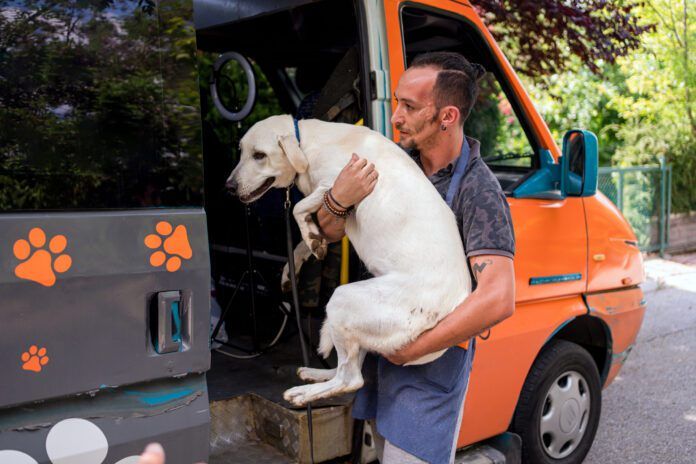The ability to pick up a large dog requires more than just strength. You need to use the proper technique, understand canine anatomy, and pay careful attention to your large dog’s comfort and safety.
Whether you are helping your dog into a vehicle, lifting them onto a grooming or exam table, or assisting a senior dog up the stairs, knowing how to properly pick up, hold, and carry a large dog can prevent injury for both you can your pet. Mishandling a big dog, even with the best intentions, can cause stress, pain, or worsen underlying conditions, especially in dogs with joint issues, injuries, or mobility concerns.
Before Picking up the Dog
Before attempting to pick up your dog, assess the situation and determine whether it is truly necessary to carry them. Even the nicest dog may lash out if they are afraid or in pain, so picking them up may not be a safe option.
Many big dogs are heavy enough that picking them up should be done only when necessary, such as in emergencies, recovery from surgeries, or when mobility is compromised. If the situation is not urgent and your dog can move on their own with some encouragement or mild assistance, that is always the safer option.
Proper Form Lifting a Heavy Dog
One of the most important aspects of lifting a big dog is maintaining proper body mechanics. Watch this excellent video that shows how to properly pick up a big dog.
Remember, just like lifting heavy objects, picking up a large dog requires using your legs, not your back:
- Stand with your knees shoulder-width apart and bend at the knees, not at the waist, keeping your back straight.
- Move calmly and confidently, as quick, jerky movements can startle a dog.
- Place one hand around the front of your dog’s chest, at the base of their front legs, to support the dog’s weight and keep them stable.
- Place your other arm behind your dog’s back legs to support their back half without placing pressure on their abdomen. This two-arm method distributed the dog’s weight evenly and prevents unnecessary strain. If your dog is too large for this, or if they have arthritic hips or joint pain, placing one arm under their chest behind their front legs with your other arm just in front of their hind legs, under the abdomen, is an alternative.
- With your arms in place and your dog feeling secure, slowly straighten your legs to lift, keeping your dog close to your body to maintain balance. The closer your dog is to your core, the more stable you will be.
Mobility Harnesses
For giant breed dogs or dogs weighing over 100 pounds, lifting your dog manually may not be practical. In these cases, equipment can make all the difference. Mobility harnesses with handles, rear-end slings, or dog stretchers are incredibly useful tools. These devices are designed specifically to support a dog’s body in a safe and ergonomic way, reducing stress on your dog’s spine and joints while also minimizing the effort required on your part. Harnesses with front and rear handles allow for two-person lifts and are particularly helpful for dogs recovering from surgery or those with chronic mobility issues such as arthritis or hip dysplasia.
Knowing how to safely pick up, hold, and carry your dog is part of being prepared for life’s unexpected moments, but if you find yourself needing to lift your dog frequently or if your dog struggles with mobility, consult with your veterinarian to explore some long-term solutions.






